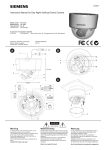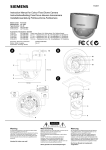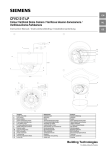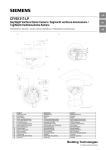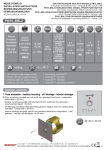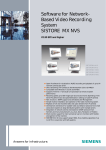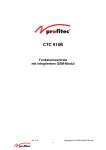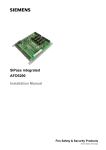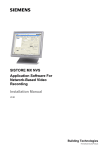Download Siemens CVVS1415-LP User's Manual
Transcript
English Instruction Manual for Day-Night Vandal Resistant Dome Camera Model number Modelnummer Typen-Nummer CVVS1415-LP Part Code Art. code Art.-Nr 2GF1185-8AE Accessories / Accessoires / Zubehör CVVA-CD 2GF1086-8AH Clear Lower Dome - Vandal Resistant / Nl: Transparante dome vandaalbestendig / De: Transparente Kuppel - Sabotagegeschützt CVVA-WB 2GF1086-8AD Wall Bracket / Nl: Muurbeugel / De: Wandhalterung CVVA-FMK 2GF1086-8AC Flush Mount Kit / Nl: Kit voor verzonken montage / De: Unterputzmontagesatz Document / Document / Dokument Edition / Editie / Ausgabe Supersedes / Vervangt / Ersetzt A24205-A336-R534 Rev A.1 - A B 15 19 14 1 16 4 18 5 2 3 4 17 5 8 6 7 C 9 2 10 11 3 12 20 13 21 WARNING WAARSCHUWING WARNUNG To reduce the risk of fire or electrical shock, do not expose this product to rain or moisture. This installation should be made by a qualified service person and should conform to all local codes. Connect the equipment to 12 V DC or 24 V AC UL Listed Class 2 Power Supply. The CAUTION label shown above is attached to the dome. Stel dit product niet bloot aan regen of vocht, want dat zou brand of een elektrische schok kunnen veroorzaken. Het installeren moet door een deskundige technicus en conform alle plaatselijk geldende voorschriften worden uitgevoerd. Sluit de apparatuur aan op een UL-gecertificeerde voeding van 12 V DC of 24 V AC, klasse 2. Bovenstaande waarschuwingssticker is op de dome bevestigd. Um die Gefahr eines Feuers oder Elektroschocks zu vermeiden, darf dieses Gerät weder Regen noch Feuchtigkeit ausgesetzt werden. Die Installation sollte von einem qualifizierten Servicetechniker gemäß den geltenden Vorschriften ausgeführt werden. Schließen Sie das Gerät an ein Netzteil mit 12 V Gleichstrom oder 24 V Wechselstrom (UL Class 2) an. Der Warnhinweis oben ist an der Kuppel angebracht. English • • • • • • Dome camera 1 service monitor cable 1 remote PC connection cable (Additional RS232 cable is required to interface to your PC (not included)) Remote software CD 2 fixing screws 2 wall plugs Fixing template Installation and operating instructions (this document) Screwdriver Dome camera parts See figures A, B and C. 1. Cable entry holes 2. Unit casing 3. Dome casing 4. Zoom lever/locking screw 5. Focus lever/locking screw 6. Iris LEVEL screw 7. V phase adjustment screw 8. Mode setting DIP switches 9. PC connection port 10. Monitor output 11. Video connnector - Auto Iris Lens 12. Power connector - Auto Iris Lens 13. Unit mounting holes 14. BNC cable 15. Power cable 16. Locking ring 17. Panning adjustment wheel 18. Axial ring 19. Conduit hole plug screw 20. Security screws 21. Security screwdriver Caution Do not turn the lens more than 360°, as this may cause internal cables to disconnect or break. 4. Lightly tighten the locking ring (16) and panning adjustment wheel (17) Step 4: Adjusting zoom and focus 1. Loosen the zoom lever/locking screw (4) by turning it counter-clockwise. 2. Rotate the zoom ring to achieve the desired picture. 3. Loosen the focus lever/locking screw (5) by turning it counter-clockwise. 4. Rotate the focus ring to adjust the focus. 5. If readjustment is necessary, repeat the steps above. 6. Retighten the zoom lever/locking screw (4) and the focus lever/locking screw (5). Caution Retighten the locking screws to prevent loss of adjustment. 7. Hold the lens and tighten the locking ring (16) and panning adjustment wheel (17). Optional settings • • • Installing the camera Step 1: Connecting the cables (a) Using the side conduit hole 1. Loosen the conduit hole plug screw (19) on the side conduit hole. Remove the plug. 2. Connect the BNC cable (14) to the video connector (11). 3. Connect the power supply cable (15) to the power connector (12). You can use 24 V AC or 12 V DC connection. Caution If using a DC supply, make sure the polarity is correct. Incorrect connection may cause malfunction and/or damage to the video camera. 4. Clean the thread grooves in the bottom conduit hole and install the removed plug firmly into the bottom conduit hole to prevent moisture from getting inside the casing. (b) Using the bottom conduit hole The BNC cable and power cable are installed through the bottom conduit hole (Factory setting). Connect the cables to the respective connectors (14)(15). Step 2: Mounting the camera 1. Place the template on the mounting surface and mark the holes. 2. Drill two holes as marked. 3. Insert the wall plugs into the holes. 4. Fasten the unit with the screws provided. Caution To ensure weatherproof rating, prior to fastening the unit the base of the dome should be completely sealed with a waterproof silicon to avoid water to penetrate. Be careful when installing the pipe /plug in the conduit hole; the screw part of the pipe /plug must be 12 mm or less so that it will not damage the inside unit. Step 3: Adjusting the camera position 1. Hold the lens so that it does not rotate. 2. Loosen the locking ring (16) and panning adjustment wheel (17). Caution Do not loosen the locking ring without holding the lens in place. Otherwise the lens may rotate with the locking ring and the cable may twist. 3. Turn the lens and axial ring (18) in the desired direction. Note If the camera does not rotate smoothly, loosen the locking ring completely. The locking ring has an internal stop and will not come off. Adjust the brightness of the picture using the Iris LEVEL screw (6): L = low, makes the picture darker H = high, makes the picture brighter Adjust the phase difference between cameras (use V Phase adjustment screw (7). Set DIP switches (8) to activate or deactivate the following features: • Backlight compensation (BLC) • Automatic gain control (AGC). • Line lock (LL). Sets camera synchronisation to internal (OFF) or line lock (ON). Line lock is only available with 24 V AC. The DC / AES DIP switch is not in use, and is always set to DC position. Step 5: Remote PC connection This camera is equipped with the latest DSP technology. The remote software kit allows remote access and further enhances the camera’s usability and functionality. Please install the remote software onto you PC in accordance with the "readme" file on the CD. Note Please read the camera’s parameters and save them to a file prior to performing any other adjustments. During this process, the picture may flicker or distort. This is normal during this operation and the picture will return to normal once completed. Additional camera functions include • Linear AGC gain control (ON: 22dB ~ 30dB; OFF: 16dB ~ 24dB) • Pedestal level adjustment (0~9 IRE) • Predefined BLC fields (6) • Sharpness (low/mid/high) • Day/Night transition level (adjustable) • Image Option (negative/monochrome) • Read camera parameters • Write to camera memory • Restore factory default settings • Save and reload parameters from file Step 6: Attaching the dome to the unit Note Use a soft, lint-free cloth to wipe the dome cover clean and remove fingerprints. 1. Clean the joint surfaces of the unit. 2. Place the dome on the unit (see figure C). 3. Match the screws on the dome casing (3) to the screw holes (3 locations) on the unit casing (2). 4. Holding the dome casing to maintain the matched positions, tighten the three screws (20) with the screwdriver (21) and lock the dome casing to the unit casing. General guidelines Operation and storage • • Avoid filming very bright objects (such as light fittings) for an extended period. Do not operate or store the unit in the following locations: • Extremely hot or cold places. • Close to sources of strong magnetism. • Close to sources of powerful electromagnetic radiation, such as radios or TV transmitters. • In humid or excessively dusty places. • Where exposed to mechanical vibrations. • Close to fluorescent lamps or objects reflecting light. • Under unstable or flickering light sources. Cleaning • • Use a soft, dry cloth to remove fingerprints or dust from the dome. If the dome is very dirty, use a small amount of mild detergent on a damp cloth for cleaning. Ensure the dome is dry before attaching the dome to the unit. Caution Do not use volatile solvents such as alcohol, benzene or thinners. These solvents may damage the surface. Transportation Use the original packing material or materials of equal quality. CCD characteristics The following conditions may be observed when using a CCD camera. These are inherent in the design and do not stem from any fault in the camera itself. • Vertical smear: This phenomenon occurs when viewing a very bright object. • Patterned noise: This is a fixed pattern which may appear over the entire monitor screen when the camera is operated at a high temperature. • Jagged picture: When viewing stripes, straight lines, or similar patterns, the image on the screen may appear jagged. Specifications General Power requirement ..........12 V DC or 24 V AC Power consumption .........3.5 W (max.) Operating temperature ....-10 to +50°C, 90% RH max. Storage temperature........-20 to +60°C, 70% RH max. External dimensions ........138 x 112 mm Weight .............................Approx. 1.7 kg Unit material ....................Aluminium Dome material .................Polycarbonate IP Rating ..........................IP66 © 2004 Siemens Building Technologies: Fire and Security Products • • • Imaging system Imaging device ................Exview™ Interline transfer 1/4 inch CCD Effective picture elements.PAL: 752(H) * 582(V) TV system........................PAL: 2:1 Interlace, 15.625 kHz horizontal, 50 Hz vertical Optical system and other specifications Day-Night Mode................Mechanical IR filter (automatic) Focal length .....................2.8 to 5.8 mm Maximum rel. aperture.....F1.4 Viewing angle .................Horizontal: 74.7° (wide angle) 35.9° (telescopic) Vertical: 55.2° (wide angle) 26.9° (telescopic) Minimum object distance . 0.2 m Synchronisation system...Internal or Line lock (24 V AC only) Horizontal resolution ........480 TV lines Minimum illumination ........0.34 lx in C/L mode 0.15 lx in B/W mode (AGC ON, more than 50% of image output, without dome cover) Video output ....................1.0 Vp-p 75 Ohm negative sync. Video S/N ratio ................More than 50 dB (AGC OFF, weighted) White balance..................Automatic (2500 K - 10000 K) AGC ..................................ON/OFF switchable ON: 30dB gain OFF: 24dB gain BLC..................................ON (Center measured) / OFF switchable (6 zones with remote software) Information This equipment has been tested and found to comply with the limits for a Class B digital device, pursuant to Part 15 of the FCC Rules. These limits are designed to provide reasonable protection against harmful interference in a residential installation. This equipment generates, uses and can radiate radio frequency energy and, if not installed and used in accordance with the instructions, may cause harmful interference to radio communications. You are cautioned that any changes or modifications not expressly approved in this manual could void your authority to operate this equipment. The shielded interface cable recommended in this manual must be used with this equipment in order to comply with the limits for a digital output device pursuant to Subpart B of part 15 of FCC rules. Data and design subject to change without notice. Package contents English Instruction Manual for Colour Vandal Resistant Dome Camera Model number Modelnummer Typen-Nummer CVVC1315-LP Part Code Art.nr. Art.-Nr 2GF1185-8AE Accessories / Toebehoren / Zubehör CVVA-CD 2GF1086-8AH Clear Lower Dome - Vandal Resistant / Nl: Transparante dome vandaalbestendig / De: Transparente Kuppel - Sabotagegeschützt CVVA-WB 2GF1086-8AD Wall Bracket / Nl: Muurbeugel / De: Wandhalterung CVVA-FMK 2GF1086-8AC Flush Mount Kit / Nl: Kit voor verzonken montage / De: Unterputzmontagesatz Document / Document / Dokument Edition / Editie / Ausgabe Supersedes / Vervangt / Ersetzt A24205-A336-R531 Rev A.1 - A 15 B 14 1 19 16 4 2 18 5 3 4 5 17 C 8 6 7 9 2 10 11 3 12 20 13 21 WARNING WAARSCHUWING WARNUNG To reduce the risk of fire or electrical shock, do not expose this product to rain or moisture. This installation should be made by a qualified service person and should conform to all local codes. Connect the equipment to 12 V DC or 24 V AC UL Listed Class 2 Power Supply. The CAUTION label shown above is attached to the dome. Stel dit product niet bloot aan regen of vocht, want dat zou brand of een elektrische schok kunnen veroorzaken. Het installeren moet door een deskundige technicus en conform alle plaatselijk geldende voorschriften worden uitgevoerd. Sluit de apparatuur aan op een UL-gecertificeerde voeding van 12 V DC of 24 V AC, klasse 2. Bovenstaande waarschuwingssticker is op de dome bevestigd. Um die Gefahr eines Feuers oder Elektroschocks zu vermeiden, darf dieses Gerät weder Regen noch Feuchtigkeit ausgesetzt werden. Die Installation sollte von einem qualifizierten Servicetechniker gemäß den geltenden Vorschriften ausgeführt werden. Schließen Sie das Gerät an ein Netzteil mit 12 V Gleichstrom oder 24 V Wechselstrom (UL Class 2) an. Der Warnhinweis oben ist an der Kuppel angebracht. • • • • • • • • • Dome camera 1 service monitor cable 1 remote PC connection cable (Additional RS232 cable is required to interface to your PC (not included)) Remote software CD 2 fixing screws 2 wall plugs Fixing template Installation and operating instructions (this document) Screwdriver Dome camera parts See figures A, B and C. 1. Cable entry holes 2. Unit casing 3. Dome casing 4. Zoom lever/locking screw 5. Focus lever/locking screw 6. Iris LEVEL screw 7. V phase adjustment screw 8. Mode setting DIP switches 9. PC connection port 10. Monitor output 11. Video connnector - Auto Iris Lens 12. Power connector - Auto Iris Lens 13. Unit mounting holes 14. BNC cable 15. Power cable 16. Locking ring 17. Panning adjustment wheel 18. Axial ring 19. Conduit hole plug screw 20. Security screws 21. Security screwdriver Installing the camera Step 1: Connecting the cables (a) Using the side conduit hole 1. Loosen the conduit hole plug screw (19) on the side conduit hole. Remove the plug. 2. Connect the BNC cable (14) to the video connector (11). 3. Connect the power supply cable (15) to the power connector (12). You can use 24 V AC or 12 V DC connection. Caution If using a DC supply, make sure the polarity is correct. Incorrect connection may cause malfunction and/or damage to the video camera. 4. Clean the thread grooves in the bottom conduit hole and install the removed plug firmly into the bottom conduit hole to prevent moisture from getting inside the casing. (b) Using the bottom conduit hole The BNC cable and power cable are installed through the bottom conduit hole (Factory setting). Connect the cables to the respective connectors (14)(15). Step 2: Mounting the camera 1. Place the template on the mounting surface and mark the holes. 2. Drill two holes as marked. 3. Insert the wall plugs into the holes. 4. Fasten the unit with the screws provided. Caution To ensure weatherproof rating, prior to fastening the unit the base of the dome should be completely sealed with a waterproof silicon to avoid water to penetrate. Step 4: Adjusting zoom and focus CCD characteristics 1. Loosen the zoom lever/locking screw (4) by turning it counter-clockwise. 2. Rotate the zoom ring to achieve the desired picture. 3. Loosen the focus lever/locking screw (5) by turning it counter-clockwise. 4. Rotate the focus ring to adjust the focus. 5. If readjustment is necessary, repeat the steps above. 6. Retighten the zoom lever/locking screw (4) and the focus lever/locking screw (5). The following conditions may be observed when using a CCD camera. These are inherent in the design and do not stem from any fault in the camera itself. • Vertical smear: This phenomenon occurs when viewing a very bright object. • Patterned noise: This is a fixed pattern which may appear over the entire monitor screen when the camera is operated at a high temperature. • Jagged picture: When viewing stripes, straight lines, or similar patterns, the image on the screen may appear jagged. Caution Retighten the locking screws to prevent loss of adjustment. 7. Hold the lens and tighten the locking ring (16) and panning adjustment wheel (17). Optional settings • • • Caution Do not turn the lens more than 360°, as this may cause internal cables to disconnect or break. 4. Lightly tighten the locking ring (16) and panning adjustment wheel (17) Imaging system Imaging device ................SuperHAD™ Interline transfer 1/3 inch CCD Effective picture elements.PAL: 752(H) * 582(V) TV system........................PAL: 2:1 Interlace, 15.625 kHz horizontal, 50 Hz vertical Optical system and other specifications Focal length .....................3.0 to 8.0 mm Maximum rel. aperture..... Aspherical F1.0 Viewing angle .................Horizontal: 91.0° (wide angle) 35.9° (telescopic) Vertical: 66.6° (wide angle) 26.9° (telescopic) Minimum object distance . 0.2 m Synchronisation system...Internal or Line lock (24 V AC only) Horizontal resolution ........480 TV lines Minimum illumination .......0.14 lx (AGC ON, more than 50% of image output, without dome cover) Video output ....................1.0 Vp-p 75 Ohm negative sync. Video S/N ratio ................More than 50 dB (AGC OFF, weighted) White balance..................Automatic (2500 K - 10000 K) AGC.................................ON/OFF switchable BLC..................................ON (Center measured) / OFF switchable (6 zones with remote software) Note Please read the camera’s parameters and save them to a file prior to performing any other adjustments. During this process, the picture may flicker or distort. This is normal during this operation and the picture will return to normal once completed. Additional camera functions include • Linear AGC gain control (18db ~ 30db) • Pedestal level adjustment (0~9 IRE) • Predefined BLC fields (6) • Sharpness (low/mid/high) • Read camera parameters • Write to camera memory • Restore factory default settings • Save and reload parameters from file Step 6: Attaching the dome to the unit Note Use a soft, lint-free cloth to wipe the dome cover clean and remove fingerprints. 1. Clean the joint surfaces of the unit. 2. Place the dome on the unit (see figure C). 3. Match the screws on the dome casing (3) to the screw holes (3 locations) on the unit casing (2). 4. Holding the dome casing to maintain the matched positions, tighten the three screws (20) with the screwdriver (21) and lock the dome casing to the unit casing. General guidelines Operation and storage • • 1. Hold the lens so that it does not rotate. 2. Loosen the locking ring (16) and panning adjustment wheel (17). Note If the camera does not rotate smoothly, loosen the locking ring completely. The locking ring has an internal stop and will not come off. Power requirement ..........12 V DC or 24 V AC Power consumption .........3.5 W (max.) Operating temperature ....-10 to +50°C, 90% RH max. Storage temperature........-20 to +60°C, 70% RH max. External dimensions ........138 x 112 mm Weight .............................Approx. 1.6 kg Unit material ....................Aluminium Dome material .................Polycarbonate IP Rating ..........................IP66 This camera is equipped with the latest DSP technology. The remote software kit allows remote access and further enhances the camera’s usability and functionality. Please install the remote software onto you PC in accordance with the "readme" file on the CD. Step 3: Adjusting the camera position 3. Turn the lens and axial ring (18) in the desired direction. General Step 5: Remote PC connection Be careful when installing the pipe /plug in the conduit hole; the screw part of the pipe /plug must be 12 mm or less so that it will not damage the inside unit. Caution Do not loosen the locking ring without holding the lens in place. Otherwise the lens may rotate with the locking ring and the cable may twist. Adjust the brightness of the picture using the Iris LEVEL screw (6): L = low, makes the picture darker H = high, makes the picture brighter Adjust the phase difference between cameras (use V Phase adjustment screw (7). Set DIP switches (8) to activate or deactivate the following features: • Backlight compensation (BLC) • Automatic gain control (AGC). • Line Lock (LL). Sets camera synchronisation to internal (OFF) or line lock (ON). Line lock is only available with 24 V AC. The DC / AES DIP switch is not in use, and is always set to DC position. Specifications Avoid filming very bright objects (such as light fittings) for an extended period. Do not operate or store the unit in the following locations: • Extremely hot or cold places. • Close to sources of strong magnetism. • Close to sources of powerful electromagnetic radiation, such as radios or TV transmitters. • In humid or excessively dusty places. • Where exposed to mechanical vibrations. • Close to fluorescent lamps or objects reflecting light. • Under unstable or flickering light sources. Cleaning • • Use a soft, dry cloth to remove fingerprints or dust from the dome. If the dome is very dirty, use a small amount of mild detergent on a damp cloth for cleaning. Ensure the dome is dry before attaching the dome to the unit. Caution Do not use volatile solvents such as alcohol, benzene or thinners. These solvents may damage the surface. Transportation Use the original packing material or materials of equal quality. Information This equipment has been tested and found to comply with the limits for a Class B digital device, pursuant to Part 15 of the FCC Rules. These limits are designed to provide reasonable protection against harmful interference in a residential installation. This equipment generates, uses and can radiate radio frequency energy and, if not installed and used in accordance with the instructions, may cause harmful interference to radio communications. You are cautioned that any changes or modifications not expressly approved in this manual could void your authority to operate this equipment. The shielded interface cable recommended in this manual must be used with this equipment in order to comply with the limits for a digital output device pursuant to Subpart B of part 15 of FCC rules. Data and design subject to change without notice. Package contents © 2004 Siemens Building Technologies: Fire and Security Products English English Instruction Manual for Monochrome Vandal Resistant Dome Camera Model number Modelnummer Typen-Nummer CVVB1315-LC Part Code Art.nr. Art.-Nr 2GF1085-8AC Accessories / Toebehoren / Zubehör CVVA-CD 2GF1086-8AH Clear Lower Dome - Vandal Resistant / Nl: Transparante dome vandaalbestendig / De: Transparente Kuppel - Sabotagegeschützt CVVA-WB 2GF1086-8AD Wall Bracket / Nl: Muurbeugel / De: Wandhalterung CVVA-FMK 2GF1086-8AC Flush Mount Kit / Nl: Kit voor verzonken montage / De: Unterputzmontagesatz Document / Document / Dokument Edition / Editie / Ausgabe Supersedes / Vervangt / Ersetzt A24205-A336-R528 Rev A.1 - A 15 B 14 1 19 16 4 2 18 5 3 4 5 17 C 8 6 7 9 2 10 11 3 12 20 13 21 WARNING WAARSCHUWING WARNUNG To reduce the risk of fire or electrical shock, do not expose this product to rain or moisture. This installation should be made by a qualified service person and should conform to all local codes. Connect the equipment to 12 V DC or 24 V AC UL Listed Class 2 Power Supply. The CAUTION label shown above is attached to the dome. Stel dit product niet bloot aan regen of vocht, want dat zou brand of een elektrische schok kunnen veroorzaken. Het installeren moet door een deskundige technicus en conform alle plaatselijk geldende voorschriften worden uitgevoerd. Sluit de apparatuur aan op een UL-gecertificeerde voeding van 12 V DC of 24 V AC, klasse 2. Bovenstaande waarschuwingssticker is op de dome bevestigd. Um die Gefahr eines Feuers oder Elektroschocks zu vermeiden, darf dieses Gerät weder Regen noch Feuchtigkeit ausgesetzt werden. Die Installation sollte von einem qualifizierten Servicetechniker gemäß den geltenden Vorschriften ausgeführt werden. Schließen Sie das Gerät an ein Netzteil mit 12 V Gleichstrom oder 24 V Wechselstrom (UL Class 2) an. Der Warnhinweis oben ist an der Kuppel angebracht. English Dome camera 1 service monitor cable 2 fixing screws 2 wall plugs Fixing template Screwdriver Installation and operating instructions (this document) Dome camera parts See figures A, B and C. 1. Cable entry holes 2. Unit casing 3. Dome casing 4. Zoom lever/locking screw 5. Focus lever/locking screw 6. Iris LEVEL screw 7. V phase adjustment screw 8. Mode setting DIP switches 9. PC connection port - Not used 10. Monitor output 11. Video connnector - Auto Iris Lens 12. Power connector - Auto Iris Lens 13. Unit mounting holes 14. BNC cable 15. Power cable 16. Locking ring 17. Panning adjustment wheel 18. Axial ring 19. Conduit hole plug screw 20. Security screws 21. Security screwdriver Step 4: Adjusting zoom and focus 1. Loosen the zoom lever/locking screw (4) by turning it counter-clockwise. 2. Rotate the zoom ring to achieve the desired picture. 3. Loosen the focus lever/locking screw (5) by turning it counter-clockwise. 4. Rotate the focus ring to adjust the focus. 5. If readjustment is necessary, repeat the steps above. 6. Retighten the zoom lever/locking screw (4) and the focus lever/locking screw (5). Caution Retighten the locking screws to prevent loss of adjustment. 7. Hold the lens and tighten the locking ring (16) and panning adjustment wheel (17). Optional settings • • • Installing the camera Step 1: Connecting the cables (a) Using the side conduit hole 1. Loosen the conduit hole plug screw (19) on the side conduit hole. Remove the plug. 2. Connect the BNC cable (14) to the video connector (11). 3. Connect the power supply cable (15) to the power connector (12). You can use 24 V AC or 12 V DC connection. Caution If using a DC supply, make sure the polarity is correct. Incorrect connection may cause malfunction and/or damage to the video camera. 4. Clean the thread grooves in the bottom conduit hole and install the removed plug firmly into the bottom conduit hole to prevent moisture from getting inside the casing. (b) Using the bottom conduit hole Step 5: Attaching the dome to the unit Note Use a soft, lint-free cloth to wipe the dome cover clean and remove fingerprints. 1. Clean the joint surfaces of the unit. 2. Place the dome on the unit (see figure C). 3. Match the screws on the dome casing (3) to the screw holes (3 locations) on the unit casing (2). 4. Holding the dome casing to maintain the matched positions, tighten the three screws (20) with the screwdriver (21) and lock the dome casing to the unit casing. General guidelines Operation and storage • • The BNC cable and power cable are installed through the bottom conduit hole (Factory setting). Connect the cables to the respective connectors (14)(15). Step 2: Mounting the camera 1. Place the template on the mounting surface and mark the holes. 2. Drill two holes as marked. 3. Insert the wall plugs into the holes. 4. Fasten the unit with the screws provided. Caution To ensure weatherproof rating, prior to fastening the unit the base of the dome should be completely sealed with a waterproof silicon to avoid water to penetrate. Be careful when installing the pipe /plug in the conduit hole; the screw part of the pipe /plug must be 12 mm or less so that it will not damage the inside unit. Step 3: Adjusting the camera position 1. Hold the lens so that it does not rotate. 2. Loosen the locking ring (16) and panning adjustment wheel (17). Caution Do not loosen the locking ring without holding the lens in place. Otherwise the lens may rotate with the locking ring and the cable may twist. 3. Turn the lens and axial ring (18) in the desired direction. Note If the camera does not rotate smoothly, loosen the locking ring completely. The locking ring has an internal stop and will not come off. Caution Do not turn the lens more than 360°, as this may cause internal cables to disconnect or break. 4. Lightly tighten the locking ring (16) and panning adjustment wheel (17). Adjust the brightness of the picture using the Iris LEVEL screw (6): L = low, makes the picture darker H = high, makes the picture brighter Adjust the phase difference between cameras (use V Phase adjustment screw (7). Set DIP switches (8) to activate or deactivate the following features: • Backlight compensation (BLC) • Automatic gain control (AGC). Automatically adjusts the picture to suit ambient brightness. • Line Lock (LL). Sets camera synchronisation to internal (OFF) or line lock (ON). Line lock is only available with 24 V AC. The DC / AES DIP switch is not in use, and is always set to DC position. Avoid filming very bright objects (such as light fittings) for an extended period. Do not operate or store the unit in the following locations: • Extremely hot or cold places. • Close to sources of strong magnetism. • Close to sources of powerful electromagnetic radiation, such as radios or TV transmitters. • In humid or excessively dusty places. • Where exposed to mechanical vibrations. • Close to fluorescent lamps or objects reflecting light. • Under unstable or flickering light sources. Cleaning • • Use a soft, dry cloth to remove fingerprints or dust from the dome. If the dome is very dirty, use a small amount of mild detergent on a damp cloth for cleaning. Ensure the dome is dry before attaching the dome to the unit. Caution Do not use volatile solvents such as alcohol, benzene or thinners. These solvents may damage the surface. Transportation Use the original packing material or materials of equal quality. CCD characteristics The following conditions may be observed when using a CCD camera. These are inherent in the design and do not stem from any fault in the camera itself. • Vertical smear: This phenomenon occurs when viewing a very bright object. • Patterned noise: This is a fixed pattern which may appear over the entire monitor screen when the camera is operated at a high temperature. • Jagged picture: When viewing stripes, straight lines, or similar patterns, the image on the screen may appear jagged. Specifications General Power requirement ..........12 V DC or 24 V AC Power consumption .........3.0 W (max.) Operating temperature ....-10 to +50°C, 90% RH max. Storage temperature........-20 to +60°C, 70% RH max. External dimensions ........140 x 112 mm Weight .............................Approx. 1.6 kg Unit material ....................Aluminium Dome material .................Polycarbonate IP Rating ..........................IP66 Imaging system Imaging device ................SuperHAD™ Interline transfer 1/3 inch CCD Effective picture elements.CCIR: 752(H) * 582(V) TV system........................CCIR: 2:1 Interlace, 15.625 kHz horizontal, 50 Hz vertical Optical system and other specifications Focal length .....................3.0 to 8.0 mm Maximum rel. aperture.....F1.0 Viewing angle .................Horizontal: 91.0° (wide angle) 35.9° (telescopic) Vertical: 66.6° (wide angle) 26.9° (telescopic) Minimum object distance . 0.2 m Synchronisation system...Internal or Line lock (24 V AC only) Horizontal resolution ........580 TV lines Minimum illumination .......0.05 lx (AGC ON, more than 50% of image output, without dome cover) Video output ....................1.0 Vp-p 75 Ohm negative sync. Video S/N ratio ................More than 50 dB (AGC OFF, weighted) AGC.................................ON/OFF switchable BLC..................................ON (Center measured) / OFF switchable © 2004 Siemens Building Technologies: Fire and Security Products • • • • • • • Information This equipment has been tested and found to comply with the limits for a Class B digital device, pursuant to Part 15 of the FCC Rules. These limits are designed to provide reasonable protection against harmful interference in a residential installation. This equipment generates, uses and can radiate radio frequency energy and, if not installed and used in accordance with the instructions, may cause harmful interference to radio communications. You are cautioned that any changes or modifications not expressly approved in this manual could void your authority to operate this equipment. The shielded interface cable recommended in this manual must be used with this equipment in order to comply with the limits for a digital output device pursuant to Subpart B of part 15 of FCC rules. Data and design subject to change without notice. Package contents






